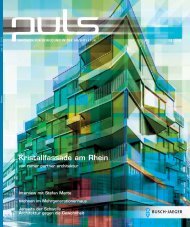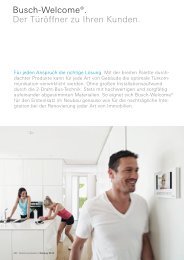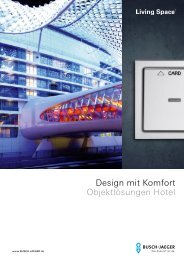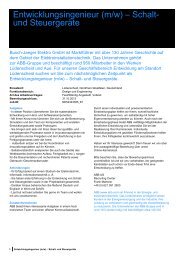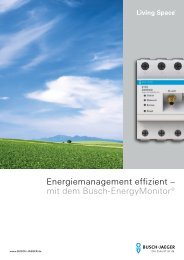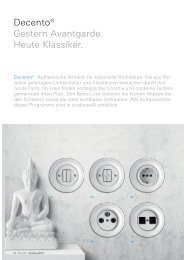The Ultimate Tower – Burj Dubai - Busch-Jaeger Elektro GmbH
The Ultimate Tower – Burj Dubai - Busch-Jaeger Elektro GmbH
The Ultimate Tower – Burj Dubai - Busch-Jaeger Elektro GmbH
You also want an ePaper? Increase the reach of your titles
YUMPU automatically turns print PDFs into web optimized ePapers that Google loves.
Top view of roof (top left) and<br />
floor plan (top right)<br />
<strong>The</strong> consumption figures for a building the size of the<br />
<strong>Burj</strong> <strong>Dubai</strong> are impressive: the thermal energy that has to<br />
be extracted from the building at peak times each day<br />
would be enough to melt 10,000 tons of ice. <strong>The</strong> cooling<br />
water for the complex comes from two nearby cooling<br />
plants, each of which could service the <strong>Burj</strong> <strong>Dubai</strong> alone<br />
in case of emergency. <strong>The</strong> base of the building houses<br />
heat exchangers and pumping stations to provide the<br />
different user zones with cooling water: two each for the<br />
residential and hotel floors, one for the office floors and a<br />
further plant for cooling drinking water, whose temperature<br />
can rise to 39 degrees centigrade in the summer.<br />
Fresh air is drawn into the tower in the service zones,<br />
then cooled by the exhaust air in a heat exchanger and<br />
later blown into the individual floors mechanically.<br />
Adjustable ABB drive units ensure that the ventilation<br />
plants, exhaust ventilators, pumps, smoke removal ventilators<br />
and fresh air blowers are working correctly<br />
matched to each other and to the external climate. <strong>The</strong><br />
<strong>Burj</strong> <strong>Dubai</strong> is fully equipped with sprinklers, for which a<br />
separate fire-fighting water system able to store 870<br />
cubic metres is provided. It is intended to be enough to<br />
prevent fire from spreading in the lower part of the tower<br />
for 90 minutes and for 30 minutes in the upper section.<br />
<strong>The</strong> skyscraper's electricity supply was set up to meet a<br />
peak load of 36 MW. For purposes of comparison: the<br />
world's largest solar power station, under construction<br />
near Leipzig at the time of writing, has a peak output of<br />
40 MW with a module area of 400,000 m2. To meet this<br />
high demand, the <strong>Burj</strong> <strong>Dubai</strong> is one of the first buildings<br />
in the Persian Gulf to have a 11 kV supply. <strong>The</strong> power is<br />
not converted to a 230 volt operating voltage until it<br />
reaches the building's own transformer. 50 gas-insulated<br />
ABB switching units control the flow of current so precisely<br />
that sections of the building's full system can<br />
be isolated for maintenance purposes or to diagnose<br />
faults. This equipment is particularly suitable for use in<br />
high-rise buildings because it takes up so little space. As<br />
well as this, five 11 kV emergency generators ensure that<br />
power can be supplied in emergencies for safety systems,<br />
selected lifts, pressure ventilation for the staircases, smokeremoval<br />
ventilators, pumps and emergency lighting.<br />
A monument to the age of oil<br />
What will happen to the <strong>Burj</strong> <strong>Dubai</strong> when it is completed,<br />
what will the world think about it in 50 or 100 years? History<br />
teaches us that monuments always gain a hold on<br />
the collective memory if they were well ahead of their<br />
19



